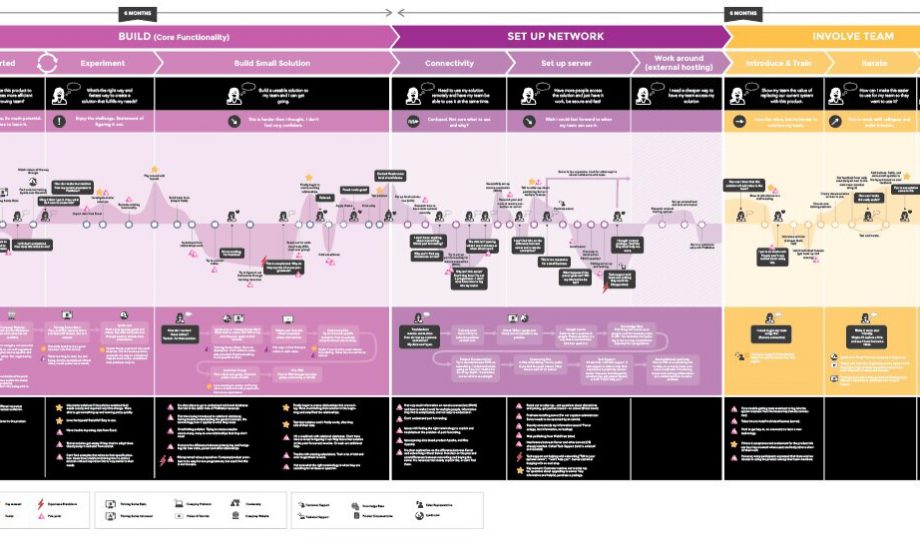While SaaS and tech companies are increasingly recognizing the importance of UX and UI design, we often still see a lag when it comes to their User Research practices––many companies are simply not investing in major discovery research or user testing when it comes to their new products and/or features. Discovery research is typically conducted in the early stages of product development; this is exploratory research conducted with real users to learn about their needs, underlying motivations, and most importantly, their biggest pain points (including interviews, observations, diary studies, and so on). User testing (also known as evaluative research) is typically conducted with real users once a product already exists, or to test early concept designs.
There are three central beliefs/challenges we’ve identified for why SaaS/tech companies are not investing in these types of research:
-
Fear of Annoying Customers: Many companies are afraid to “bother” their customers. In this case, they might prefer to rely on proto-personas or proxy users (e.g. a customer support employee who deals very closely with the end user) for information about pain points and needs.
-
Time & Resources: Some organizations feel like they simply do not have the time for this type of (sometimes) extensive research. Teams may be so focused on feature design, development, and the next release that there is little time or resources to pause and give dedicated team members several weeks (or potentially months) to dive into their users’ psyche.
-
Lack of Understanding: At the same time, we still encounter companies who don’t truly value UX research, or who fail to see its full potential. These companies may find qualitative research “fluffy” and hard-to-define, and they usually aren’t clear on the types of big outcomes they could expect from solid user research. They might also prefer the “hard” facts and numbers they can gather from A/B testing and data analytics.
However––all three of these challenges are based in myth! Let us explain why:
-
Fear of Annoying Customers: From our experience, customers are actually very happy to provide feedback to the companies they buy from! It helps them feel valued, and it’s nice for users to feel like their opinion has an impact that can make their own experience––and that of others––better. This is especially true for customers who use your application/product on a daily basis. Bringing users into the more detailed/product-related research is a great way to involve them in the experience of creation and to build loyalty. Who wouldn’t be invested in a product they helped to define?
Also, if you plan your user research properly and have strong communication across departments, the company shouldn’t be reaching out to customers again and again. For example, if the marketing team is reaching out to customers––can the UX research team “double dip” and make it a joint initiative?
Furthermore, a small monetary incentive can go a long way to compensate customers for their time, so that they feel grateful for the experience (instead of feeling annoyed by it). At Outwitly, we have conducted hundreds of user interviews, and we commonly hear things like “Thanks so much for involving me!”, “I’m really excited to see some of these changes come to life!”, and even “Feel free to reach out to me again if you have more questions!”.
-
Time & Resources: This can be a tough one. Every organization could use more time, more money, and more hands to get work done. That said, managing time and resources is mostly about prioritization and planning. If you have a big budget but lack time, you can hire an external team to conduct research for you while working in tandem with your other product development releases. If you have a lot of time but a smaller budget, your own design team can take on the work and plan it through. However, if you are short on both time and money, you’ll want to consider getting scrappy with UX research. For example, set up some quick, short rounds of user testing early on with five to eight users.
One thing is certain: when your organization starts investing in UX research, you will see market shares increase, and the speed at which you are able to create successful products/features––that don’t require a million revisions––will become much quicker (we get into this at more length below). Therefore, by doing research with real users, your company will actually save time and money in the long run.
-
Lack of Understanding: Tricky, tricky! This challenge requires some stakeholder buy-in at the top of the organization. If your execs, directors, and managers believe in the power of research, they will make sure it’s a priority for the team. If not, you may have to “prove by doing”, and by showcasing your small wins. Start off with a smaller research engagement (like the one mentioned above) if your organization is new to the concept of UX research.
And if you face any of these challenges today––keep reading! We’ll prove why doing qualitative research with your users and/or customers has a huge return on investment (ROI).
Product Launches (and why they can be risky)
Before we outline the benefits of UX research, let’s first dive into some common issues and challenges we see with product launches and new feature releases.
-
They miss the mark completely. Yikes! This is when a new product or feature falls short of the marketing, and simply isn’t useful to your users and customers. It just wasn’t what they needed, and maybe not what you promised. You don’t want this to happen.
-
Too many bugs and a full customer support queue as a result. Maybe you rushed to get your product or feature out there, but it wasn’t quite ready… and the user experience is now clunky and hard-to-use. Maybe there wasn’t enough time for QA to do all the necessary testing, which in turn leads to many unhappy and frustrated users calling your customer support team for help. This can be a costly mistake. The more human touch required per account/user, the more expensive it is for your company.
-
Product/feature is just “okay” and doesn’t provide a lot of value. This challenge is a lot less offensive: your new product or feature is “just okay”. It’s not great, it’s not horrible––but at the same time it provides no real value to the customer, and provides no real differentiator between other competitors on the market. Less offensive, yes, but who wants to be mediocre!?
You want to be the best in your market, so how can you do that?
The good news is that if your UX design and product development is already working like a well-oiled machine, UX research can be integrated seamlessly into that process and can help take your product to the next level in this HIGHLY competitive market. According to a 2020 report by Blissfully, the overall spend per company on SaaS products has increased 50%, and the average mid-market business uses an average of 137 apps. Distinguishing new products on this wild playing field is more important than ever.
In a previous post, we talked about how UX Research and customer journey mapping conducted during the trial period can convert more customers to fully paid licenses. What about in the context of product launches and feature releases?
View this post on Instagram
Here is how UX research can help de-risk your product launches and add value:
-
Uncover hidden opportunities to differentiate your product. Conducting human-centered discovery research (through interviews or observations) will help you to uncover users’ unspoken needs. This is crucial, because UX researchers can give customers/users a voice in product development by identifying their major pain points with existing products. In turn, this can lead to new ideas for improvement, as well as potentially sparking ideas for bold innovation that will set your company and products apart from the competition.
-
Reduce customer churn. Finding out what people really want and need ensures the product or feature you are creating is truly valuable and desirable. This is a major principle of human-centered research and design, as well. Customers are more likely to stick around when they see a product that really solves a need (and is always improving). It’s kind of like your company solved their problem before they even realized they had a problem (like you read their minds…because with user research, you kind of did!)
-
Proof of concept. It’s important to make sure your new product or feature is viable before spending immense time and money (see our final point below) to develop and design it. UX research with real users allows you to check your ideas and designs before building the new product/feature and tackling all the detail design.
-
Saves time and money. Finally, testing early and often will ensure you don’t get off track with the design, and that the interface is easy to use from the get-go. Leveraging the data/insights gathered from research and testing will only serve to reduce the number of design iterations and development cycles, since you are working from real facts instead of assumptions. In other words, by understanding what your customers want at an early stage, you can build a clickable prototype quickly and cheaply, gather feedback, and then spend time developing and launching a product or feature that you know will succeed!
Get started with UX research today! Here are a few types of research your company could start using right away:
-
Contextual Observations via screen-sharing or a walkthrough
-
Surveys
-
Rapid Prototyping
-
Usability Testing
At the end of the day, UX research will ultimately de-risk your launches by providing a safety net of hard data and insights that your team can leverage to develop, design, and launch competitive products and features your customers will love.





